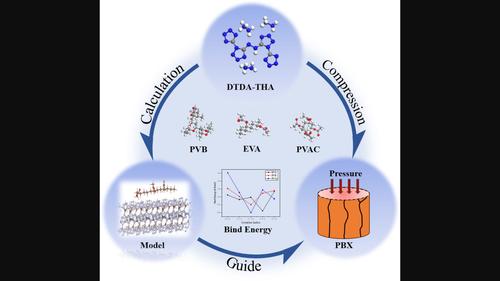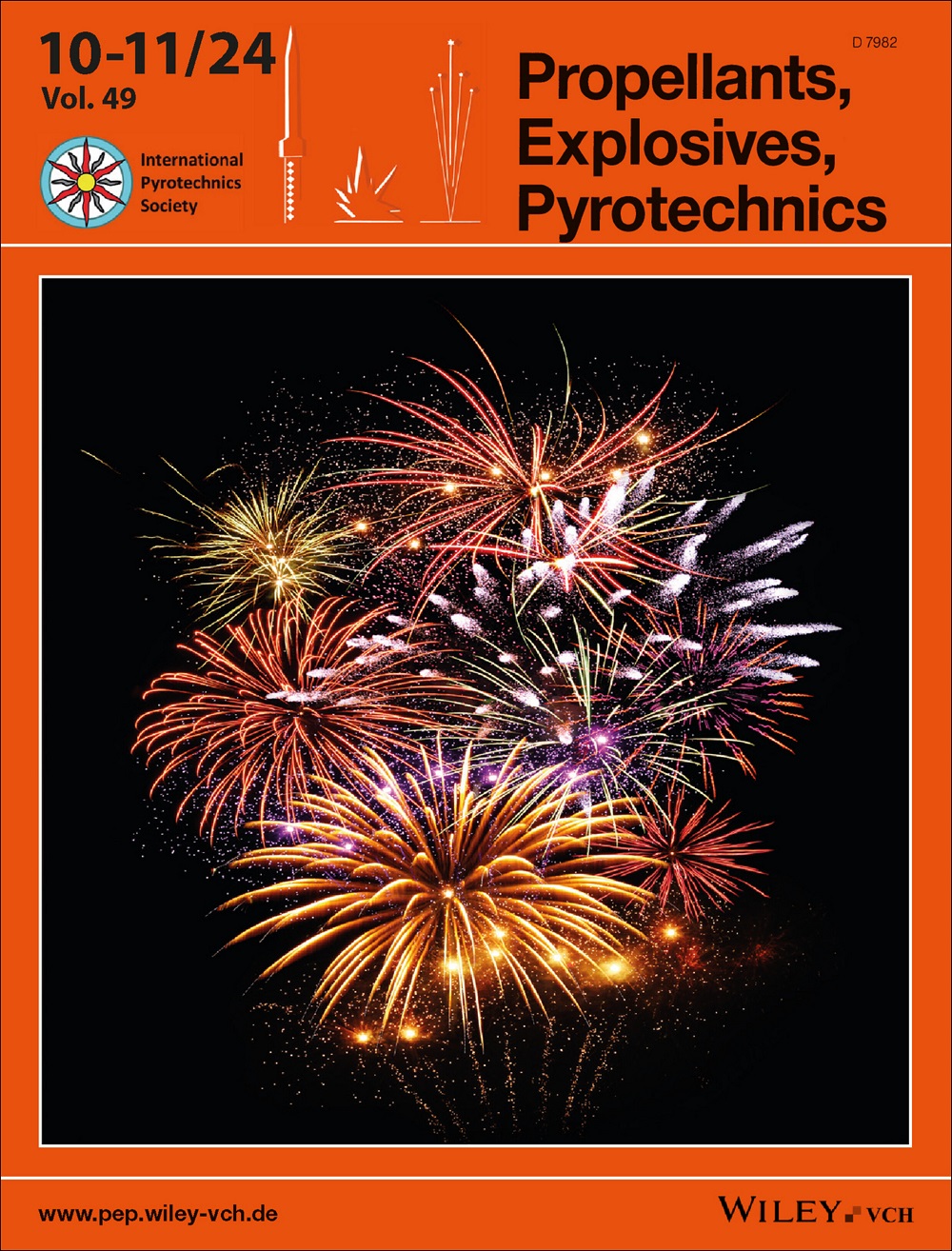Study on the safety and mechanical properties of a new tetrazole-based energetic material
IF 2
4区 工程技术
Q3 CHEMISTRY, APPLIED
引用次数: 0
Abstract
DTDA-THA (tris(hydrazin-1-ium)5,5′-(hydrazin-1-ide-1,2-diylbis((1H-tetrazole-5,1-diyl)))bis(tetrazol-2-ide)) is a novel type of poly-nitrogen energetic material characterized by high nitrogen content, high enthalpy of formation, and low sensitivity. To research the application of DTDA-THA in polymer-bonded explosives (PBXs) and improve the safety performance of DTDA-THA in composite explosives, this study calculated the binding energies between ethylene-vinyl acetate copolymer (EVA), polyvinyl butyral (PVB), polyvinyl acetate (PVAc) and DTDA-THA via density functional theory, respectively. Three types of PBXs molding powders were prepared through the direct method. For further investigation, the moisture absorption of molding powders, the forming density, and the compressive strength of the grains under different binders were characterized. The result of the simulation shows higher binding energy between the crystal surface (2 −1 2) and different binders. The comprehensive order of the binding energies between different binders and the crystal surface of DTDA-THA was DTDA-THA@EVA>DTDA-THA@PVB>DTDA-THA@PVAc. The experimental results show that the addition of binder reduced the hygroscopicity of DTDA-THA and improved the sensitivity and mechanical properties of the molding powders. Under the same binder proportion, the formulation prepared by PVAc had a higher molding density, while the formulation prepared by PVB exhibited the best compressive strength.

新型四氮唑基能量材料的安全性和机械性能研究
DTDA-THA(三(肼-1-ium)5,5′-(肼-1-ide-1,2-二基双((1h -四唑-5,1-二基)))双(四唑-2-ide))是一种新型的多氮能材料,具有高氮含量、高生成焓和低灵敏度的特点。为了研究DTDA-THA在聚合物粘合炸药(PBXs)中的应用,提高DTDA-THA在复合炸药中的安全性能,本研究分别通过密度泛函数理论计算了乙烯-乙酸乙烯共聚物(EVA)、聚乙烯醇丁醛(PVB)、聚乙烯醇乙酸乙烯酯(PVAc)和DTDA-THA之间的结合能。采用直接法制备了三种不同类型的PBXs成型粉末。为进一步研究成型粉末的吸湿性、成型密度和颗粒在不同粘结剂下的抗压强度。模拟结果表明,晶体表面(2−12)与不同粘结剂之间的结合能较高。不同粘结剂与DTDA-THA晶体表面的结合能综合顺序为DTDA-THA@EVA>DTDA-THA@PVB>DTDA-THA@PVAc。实验结果表明,粘结剂的加入降低了DTDA-THA的吸湿性,提高了成型粉的灵敏度和力学性能。在相同的粘结剂配比下,PVAc制备的配方具有较高的成型密度,而PVB制备的配方具有最佳的抗压强度。
本文章由计算机程序翻译,如有差异,请以英文原文为准。
求助全文
约1分钟内获得全文
求助全文
来源期刊

Propellants, Explosives, Pyrotechnics
工程技术-工程:化工
CiteScore
4.20
自引率
16.70%
发文量
235
审稿时长
2.7 months
期刊介绍:
Propellants, Explosives, Pyrotechnics (PEP) is an international, peer-reviewed journal containing Full Papers, Short Communications, critical Reviews, as well as details of forthcoming meetings and book reviews concerned with the research, development and production in relation to propellants, explosives, and pyrotechnics for all applications. Being the official journal of the International Pyrotechnics Society, PEP is a vital medium and the state-of-the-art forum for the exchange of science and technology in energetic materials. PEP is published 12 times a year.
PEP is devoted to advancing the science, technology and engineering elements in the storage and manipulation of chemical energy, specifically in propellants, explosives and pyrotechnics. Articles should provide scientific context, articulate impact, and be generally applicable to the energetic materials and wider scientific community. PEP is not a defense journal and does not feature the weaponization of materials and related systems or include information that would aid in the development or utilization of improvised explosive systems, e.g., synthesis routes to terrorist explosives.
 求助内容:
求助内容: 应助结果提醒方式:
应助结果提醒方式:


